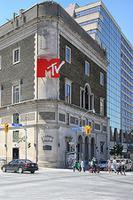This content is from a series created in partnership with Museum Services of the City of Toronto and Heritage Toronto. We gratefully acknowledge funding from the Ontario Ministry of Tourism, Culture and Sport, and the Department of Canadian Heritage.
Toronto Feature: Masonic Temple
"Led Zeppelin at the Masonic Temple"
The imposing, six-storey building at the corner of Davenport Road and Yonge Street stands as a testament to the strength of the city's early Freemasons. As a venue for concerts, the Masonic Temple saw everyone from Frank Sinatra to David Bowie grace its stage. Its glory days came in the late 1960s when it was known as the Rock Pile and featured now legendary performances by Led Zeppelin and others.
Opened in 1918, the Masonic Temple was the Freemasons' official headquarters; by 1920 it was home to 18 lodges. In the mid-1960s, after decades of stability, the temple began to experience financial difficulty as tenants relocated to temples constructed in other areas of the growing city. The Masons began renting out the facility for music, theatrical and public speaking events. Among the many stars who performed there were Bing Crosby, Stan Kenton, Iggy Pop and King Sunny Adé.
The Temple's heyday came during the psychedelic era when it was called the Rock Pile and featured concerts by the Who, Procol Harum and the Mothers of Invention lit up by strobes and liquid projectors provided by Catharsis Lights. The Rock Pile was famously the scene of two separate 1969 visits by Led Zeppelin, the first in February when the band was virtually unknown and the second in August after the group had stormed up the charts. Before the latter appearance, Zeppelin's manager extorted a crippling extra fee from the promoters, ultimately bankrupting the Rock Pile, which closed shortly afterwards. The building remained a Masonic asset until 1994, when costs for its maintenance and improvement became prohibitive.

 Partager sur Facebook
Partager sur Facebook Partager sur X
Partager sur X Partager par Email
Partager par Email Partager sur Google Classroom
Partager sur Google Classroom


